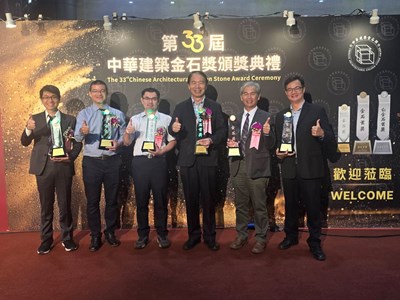
The Water Resources Bureau noted that the Shinguang Water Resources Recycling Center breaks the traditional perception of wastewater plants as cold and rigid. High walls have been replaced with peripheral water channels and green belts, connecting the facility to Dongying Park and Xiangshun Sports Park. Mature banyan trees have been preserved, and a rooftop garden has been installed, allowing the facility to harmoniously integrate with the surrounding community landscape. Within the park, treated water is recycled for internal operations, park irrigation, and public use. The facility is also open for visits, introduce the “Black Water” café, and hosts campus art exhibitions, transforming the wastewater plant into a space for public interaction and recreation. The site further supports ecological development, attracting fireflies, dragonflies, and migratory birds, demonstrating the triple value of water purification, environmental education, and ecological conservation.
The Huilai Creek and Chaoyang Creek Water Environment Improvement Project (Phase II) builds on the achievements of Phase I by extending the scope upstream, enhancing pedestrian pathways and planting spaces, and integrating community nodes to create a comfortable green corridor. The Liuchuan Water Environment Improvement Master Plan (Phase III) envisions a “low-impact, low-carbon urban oasis reflecting the interplay between rivers and people.” The project employs reduced-concrete construction, low-impact development, and green engineering methods while increasing vegetation coverage. These measures not only bring people closer to the river but also provide suitable habitats for wildlife.
The Dazhi Drainage Water Environment Improvement Master Plan (Phase I), located at the intersection of East, South, and Dali Districts, adopts Nature-Based Solutions (NBS) and Low Impact Development (LID) techniques. By leveraging ecological planting, the project enhances urban flood resilience while reducing structural levees where safety allows. Additional recreational facilities and walking trails have also been incorporated. During the planning process, residents were actively invited to participate and provide feedback, ensuring the project aligns with local needs. Upon completion, the project will comprehensively improve the environmental quality of the Dazhi Drainage area.
The Water Resources Bureau also noted that upon completion, the Guguan Sewer System Construction Project will be able to treat approximately 300 tons of domestic wastewater daily, significantly improving local environmental sanitation. The exterior design of the Water Resources Recycling Center incorporates Atayal tribal totems, reflecting indigenous culture while integrating tourism and natural landscapes. This approach not only challenges conventional perceptions of engineering projects but also promotes the harmonious development of local industries and the environment, contributing to the growth of Heping District.
The Water Resources Bureau emphasized that the award recognize not only the team’s dedication but also the achievements of Taichung City in advancing water environment projects that balance ecological conservation, flood safety, and recreational spaces. Moving forward, the city government will continue to promote near-natural engineering projects, progressing toward a livable, resilient, and sustainable waterfront city.
(9/16*14)* Water Resources Bureau
Contact: Mr. Huang, Water Resources Bureau, Taichung City Government
Phone: 04-22289111 ext. 53112

 Facebook
Facebook
 Twitter
Twitter
 LINE
LINE